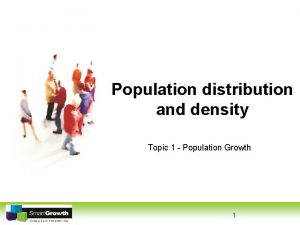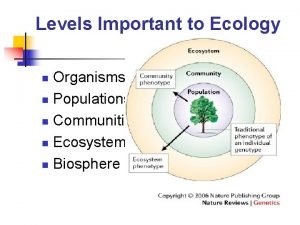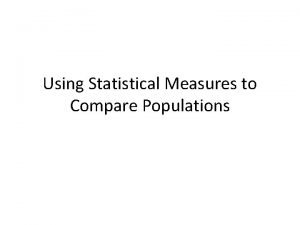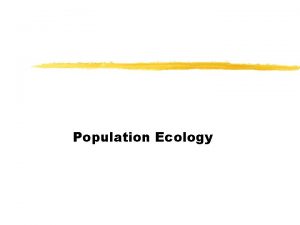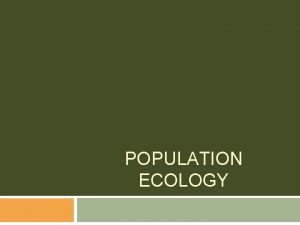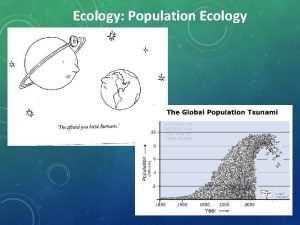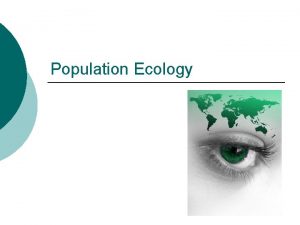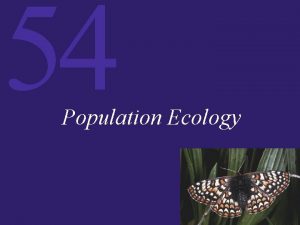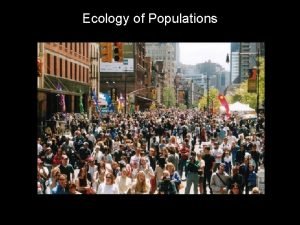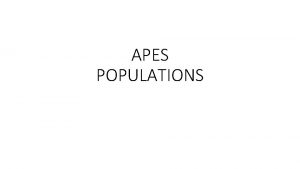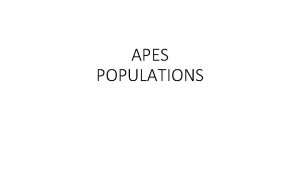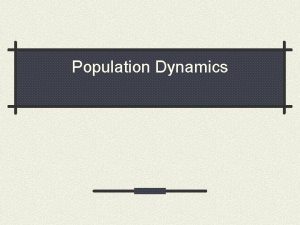Population Ecology Populations Population all individuals of 1



























- Slides: 27

Population Ecology!

Populations Population: all individuals of 1 species in area Population size : number of individuals Population density : number per area Population distribution : dispersal pattern

Distribution patterns 1) Clumped: most common, a) group around resources b) social behavior c) lack of offspring dispersal 2) Uniform (or close enough) a) territory division 3) Random – rare a) uniform resources b) ignore each other

Population Size Estimates 1) full count 2) Quadrats 3) Transects 4) Mark-recapture m-r good for organisms that move around a lot

Mark-recapture Based on assumption: % marked on day 2 same as the % of the total population that is marked Steps: day 1 capture organisms & mark them day 2 capture organisms & see what % are marked calculation day 2 marked = day 1 marked day 2 total population

Population Growth Positive growth ……. . birth & immigration Negative growth …… death & emigration Migration : periodic change w/ seasons Net reproduction = births – deaths Per capita = per individual Doubling time: time for pop to double size

Rapid Population Growth Exponential growth : population grows at a rate proportional to its size a) ideal conditions allow max growth rate Biotic potential : max growth rate for a population (under ideal conditions)

Logistic Population Growth Exponential Growth slowed by Density dependent limiting factors predation, parasites, disease limited resources, competition Not by Density independent limiting factors weather, natural disasters, humans


Carrying capacity = Max # individuals an area can support indefinitely (D) Steady state #2 on graph

Life History Strategies r-selected a) favor low pop density (d independent) b) quick production of many small babies c) high biotic potential so called r-selected K-selected a) favor high pop density (d dependent) b) good competitors c) low biotic potential & parental care

Life History Strategies

Different Life Histories = Different Survivorship Curves Type I : live long & prosper (parental care) k-selected Type II : good luck could die at any time… Type III : by-by baby high infant mortality r-selected


Human Population growth 1 to 2 billion…………. . 123 years Growth to 3 billion …………. 33 years Growth to 4, 5, 6 …………. . 14, 13, 12

Demographics 1. study of population statistics 2. Number of individuals of a. different age groups b. socioeconomic status c. education levels d. other 3. Used by ecologists to predict population growth

Age Structure Diagrams 1. Demographic Model (graph) of Age groups 2. Age groups for predicting population growth a. Post – reproductive: too old to reproduce b. Reproductive: currently able to reproduce c. Pre - reproductive: too young to reproduce



http: //data. worldbank. org/indicator/SP. DY N. IMRT. FE. IN? end=2016&start=1968&vie w=chart https: //www. cia. gov/library/publications/the -world-factbook/geos/ng. html

Singapore Lowest TFR : 0. 82 Education: 3 % of GDP literacy rate: 97% Education: Infant mortality rate: 2. 4 / 1, 000 Mother age at first birth : 30. 5

World Highest TFR : Education: literacy rate: 86% Education: Infant mortality rate: Mother age at first birth : Contraceptive prevalence Child labor:

U. S. A. Medium TFR : 1. 9 Education: literacy rate: 99% Education: Infant mortality rate: 5. 8 / 1, 000 Mother age at first birth : 26 Contraceptive prevalence 74%

Niger Highest TFR : 6. 6 Education: literacy rate: 19% Education: Infant mortality rate: 83 / 1, 000 Mother age at first birth : 18 Contraceptive prevalence 14% Child labor: 43%

Demographic Transition Model

Fertility Rates and $$$$$$$ Total Fertility Rate (TFR) – average # children born per woman Replacement = 2. 1 USA = 1. 87 Niger = 6. 6 Signapore: TFR Infant mortality = 2. 4/1, 000 TFR in developed countries = at or below 2. 1

 Individuals don't evolve populations do
Individuals don't evolve populations do Chapter test a chapter 4 population ecology answer key
Chapter test a chapter 4 population ecology answer key Population ecology section 1 population dynamics answer key
Population ecology section 1 population dynamics answer key Population ecology section 1 population dynamics
Population ecology section 1 population dynamics Chapter 4 population dynamics study guide answers
Chapter 4 population dynamics study guide answers Logistic growth ecology definition
Logistic growth ecology definition Exponential population growth
Exponential population growth Fig 52
Fig 52 Ecosystem vs community
Ecosystem vs community Concept 3 population ecology
Concept 3 population ecology Chapter 53 population ecology
Chapter 53 population ecology Chapter 36 population ecology
Chapter 36 population ecology Chapter 4 population ecology answer key
Chapter 4 population ecology answer key Lynx and hare relationship
Lynx and hare relationship Chapter 53 population ecology
Chapter 53 population ecology Characteristic of population
Characteristic of population Chapter 4 section 1 population dynamics
Chapter 4 section 1 population dynamics Population characteristics ecology
Population characteristics ecology What is population ecology
What is population ecology Population definition ecology
Population definition ecology Population distribution
Population distribution Parasitism
Parasitism Chapter 53 population ecology
Chapter 53 population ecology Name all rays
Name all rays Using statistical measures to compare populations
Using statistical measures to compare populations Territoires populations et développement quels défis
Territoires populations et développement quels défis Stabilizing selection human birth weight
Stabilizing selection human birth weight A biologist discovers two populations of wolf spiders
A biologist discovers two populations of wolf spiders




















